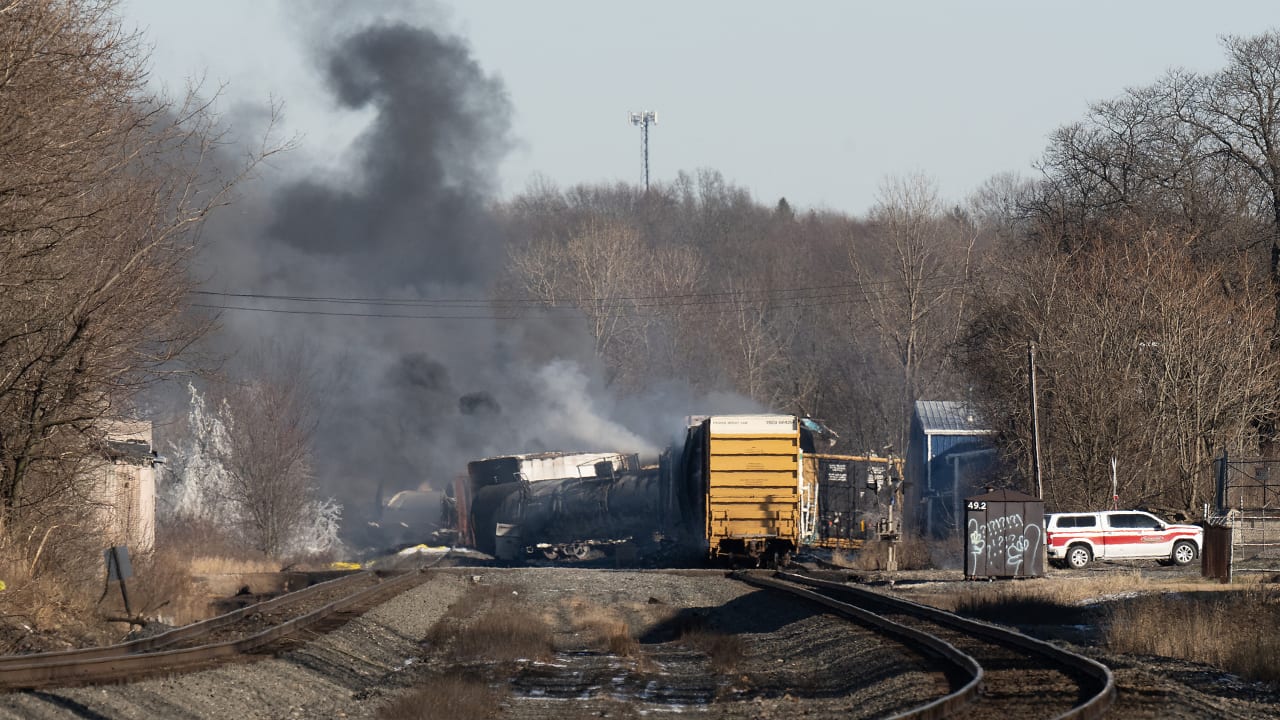Ohio Train Derailment: Toxic Chemical Lingering In Buildings

Table of Contents
- Evidence of Lingering Toxic Chemicals
- Vinyl Chloride Contamination
- Other Contaminated Substances
- Contamination Pathways
- Health Concerns Related to Chemical Exposure
- Short-Term Health Effects
- Long-Term Health Effects
- Challenges in Assessing Health Impacts
- Ongoing Challenges and Response
- Cleanup Efforts and Their Limitations
- Government Response and Accountability
- Support for Affected Residents
- Conclusion
Evidence of Lingering Toxic Chemicals
The presence of toxic chemicals in buildings following the derailment is a major concern. Initial investigations focused on immediate hazards, but the long-term consequences of building contamination are only now coming into sharper focus.
Vinyl Chloride Contamination
Vinyl chloride, a known carcinogen, was a primary chemical released in the derailment. Evidence suggests its persistence within buildings presents a significant threat.
- Detected Levels: Reports indicate detectable levels of vinyl chloride have been found in several homes and businesses near the derailment site, though precise data remains limited due to ongoing testing and varying methodologies.
- Testing Methodologies: Various methods, including air sampling, soil analysis, and water testing, are being employed, but inconsistencies in methodology make comparing results challenging.
- Challenges in Accurate Measurement: The volatile nature of vinyl chloride and the porous nature of some building materials complicate accurate measurement and assessment of long-term contamination.
- Long-Term Effects of Vinyl Chloride Exposure: Long-term exposure to vinyl chloride is linked to an increased risk of several cancers, including liver cancer, brain cancer, and lung cancer.
Other Contaminated Substances
Beyond vinyl chloride, other toxic chemicals released in the derailment, including butyl acrylate and ethylene glycol monobutyl ether, pose further health risks.
- Other Chemicals and Their Toxicity: These chemicals, each with their unique toxic properties, add to the complexity of the situation and present cumulative risks. Butyl acrylate is an irritant affecting eyes, skin, and lungs. Ethylene glycol monobutyl ether is a potential kidney and liver toxin.
- Potential Synergistic Effects: The combined effects of multiple chemicals could be significantly more damaging than exposure to a single substance, compounding the health risks for residents.
- Difficulty of Complete Removal: The pervasive nature of the contamination, combined with the varied properties of the chemicals, presents a significant challenge to complete removal and remediation.
Contamination Pathways
The chemicals infiltrated buildings through several pathways, ensuring long-term contamination concerns.
- Air Infiltration: Volatile organic compounds (VOCs) like vinyl chloride readily entered buildings through air infiltration, contaminating indoor air quality.
- Water Contamination: Groundwater and surface water contamination pose a risk of chemical leaching into building foundations and basements.
- Direct Contact: Initial spills and the subsequent cleanup efforts may have resulted in direct contact contamination of building materials and surfaces.
- Porous Building Materials: Materials such as wood, drywall, and insulation can absorb chemicals, creating reservoirs for long-term release.
Health Concerns Related to Chemical Exposure
The health consequences of exposure to the toxic chemicals released in the Ohio train derailment are a major concern for residents.
Short-Term Health Effects
Residents have reported a wide range of immediate health problems following the derailment, indicating acute exposure to the released chemicals.
- Headaches, Nausea, and Respiratory Issues: Many residents experienced headaches, nausea, vomiting, and difficulty breathing immediately following the derailment.
- Skin Irritation: Reports of skin irritation and rashes are consistent with exposure to certain chemicals released.
- Medical Reports and Resident Testimonies: These reports come from both official medical assessments and numerous firsthand accounts from affected residents.
Long-Term Health Effects
The long-term health consequences of exposure to these chemicals are particularly worrying and require extensive monitoring.
- Cancer Risk: The presence of carcinogens such as vinyl chloride significantly increases the long-term cancer risk for exposed individuals.
- Reproductive Problems: Some of the chemicals released can have detrimental effects on reproductive health.
- Neurological Damage: Exposure to certain chemicals can lead to neurological problems and cognitive impairments.
- Relevant Studies and Scientific Literature: Ongoing research is crucial to fully understand the long-term health impacts, building on existing studies of similar chemical exposures.
Challenges in Assessing Health Impacts
Accurately assessing the long-term health effects presents significant challenges.
- Need for Long-Term Monitoring: A comprehensive, long-term health monitoring program is essential to track health outcomes in the affected population.
- Limitations of Current Data: Current data is limited by the recency of the event and the complexities of assessing the health impacts of multiple chemical exposures.
- Need for More Research: Further research is crucial to understand the synergistic effects of different chemicals and the long-term health consequences.
Ongoing Challenges and Response
The ongoing response to the Ohio train derailment highlights the significant challenges in environmental cleanup and community support.
Cleanup Efforts and Their Limitations
Cleanup efforts are underway, but significant limitations remain.
- Methods Used: Cleanup methods include soil remediation, water treatment, and air purification, but their effectiveness in completely removing persistent contamination remains uncertain.
- Areas of Difficulty: The pervasiveness of the contamination and the complexities of removing chemicals from various building materials pose substantial challenges.
- Long-Term Cleanup Strategy: A comprehensive long-term strategy is required, considering the persistent nature of the contamination and the potential for future releases.
- Monitoring of Effectiveness: Rigorous monitoring is needed to assess the effectiveness of cleanup efforts and ensure the long-term safety of the community.
Government Response and Accountability
The government's response to the crisis has faced criticism.
- Actions Taken: The government has undertaken various actions, including providing resources for cleanup and health monitoring, but their adequacy is a subject of ongoing debate.
- Criticisms of the Response: Many critics point to the initial response's slowness and lack of transparency, highlighting concerns about accountability.
- Potential Legal Ramifications: The derailment has resulted in numerous lawsuits, raising questions of liability and accountability for the long-term consequences.
Support for Affected Residents
Ongoing support for the affected residents is paramount.
- Financial Assistance: Financial assistance is crucial for residents facing property damage, medical expenses, and lost income.
- Healthcare Access: Ensuring access to comprehensive healthcare, including long-term monitoring, is essential.
- Mental Health Support: The emotional toll on residents requires significant mental health support services.
- Relocation Options: In some cases, relocation may be necessary to safeguard residents' health and well-being.
Conclusion
The Ohio train derailment’s impact extends far beyond the immediate aftermath. Lingering toxic chemicals in buildings pose a significant and ongoing threat to the health and well-being of East Palestine residents. The challenges in accurately assessing long-term health impacts, coupled with the limitations of current cleanup efforts, underscore the need for sustained vigilance, accountability, and comprehensive support for the affected community. The long-term effects of the Ohio train derailment and the lingering presence of toxic chemicals in buildings demand continued attention and action.
Call to Action: Stay informed about the ongoing situation in East Palestine, support affected residents through donations or volunteering, and demand accountability from responsible parties for the long-term consequences of this environmental disaster. Contact your representatives to advocate for increased funding for research, robust cleanup efforts, and comprehensive long-term health monitoring of the Ohio train derailment’s impact. We must ensure that those affected receive the necessary support and that measures are implemented to prevent future disasters.

 Roche Q1 2024 Sales Growth Pipeline Strength Drives Results
Roche Q1 2024 Sales Growth Pipeline Strength Drives Results
 Kak Izmenilas Pozitsiya Trampa Po Voyne V Ukraine Analiz Ritoriki
Kak Izmenilas Pozitsiya Trampa Po Voyne V Ukraine Analiz Ritoriki
 Wednesday Storm Timeline Hail And Strong Wind Warnings For Oklahoma
Wednesday Storm Timeline Hail And Strong Wind Warnings For Oklahoma
 Eurovision 2025 Betting A Comprehensive Guide To Odds And Predictions
Eurovision 2025 Betting A Comprehensive Guide To Odds And Predictions
 Rick Astleys Affection For Liverpool First Place In His Fans Hearts
Rick Astleys Affection For Liverpool First Place In His Fans Hearts
